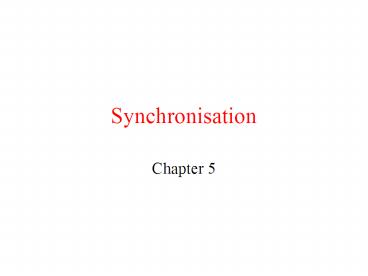Synchronisation - PowerPoint PPT Presentation
1 / 32
Title:
Synchronisation
Description:
Leap seconds are introduced when necessary to keep in phase with the sun. ... The time daemon tells everyone how to adjust their clock. Lamport Timestamps ... – PowerPoint PPT presentation
Number of Views:97
Avg rating:3.0/5.0
Title: Synchronisation
1
Synchronisation
- Chapter 5
2
Clock Synchronisation
- When each machine has its own clock, an event
that occurred after another event may
nevertheless be assigned an earlier time.
3
Physical Clocks (1)
- Computation of the mean solar day.
4
Physical Clocks (2)
- TAI seconds are of constant length, unlike solar
seconds. Leap seconds are introduced when
necessary to keep in phase with the sun.
5
Clock Synchronization Algorithms
- The relation between clock time and UTC when
clocks tick at different rates.
6
Cristian's Algorithm
- Getting the current time from a time server.
7
The Berkeley Algorithm
- The time daemon asks all the other machines for
their clock values - The machines answer
- The time daemon tells everyone how to adjust
their clock
8
Lamport Timestamps
- Three processes, each with its own clock. The
clocks run at different rates. - Lamport's algorithm corrects the clocks.
9
Example Totally-Ordered Multicasting
- Updating a replicated database and leaving it in
an inconsistent state.
10
Global State (1)
- A consistent cut
- An inconsistent cut
11
Global State (2)
- Organisation of a process and channels for a
distributed snapshot
12
Global State (3)
- Process Q receives a marker for the first time
and records its local state (and sends out a
marker on its outgoing channels) - Q records all incoming messages
- Q receives a marker for its incoming channel and
finishes recording the state of the incoming
channel
13
The Bully Algorithm (1)
- The bully election algorithm to elect a
coordinator - Process 4 holds an election
- Process 5 and 6 respond, telling 4 to stop
- Now 5 and 6 each hold an election
14
Global State (3)
- Process 6 tells 5 to stop
- Process 6 wins and tells everyone
15
A Ring Algorithm
- Election algorithm using a ring.
16
Mutual Exclusion A Centralised Algorithm
- Process 1 asks the coordinator for permission to
enter a critical region. Permission is granted - Process 2 then asks permission to enter the same
critical region. The coordinator does not
reply. - When process 1 exits the critical region, it
tells the coordinator, which then replies to 2
17
A Distributed Algorithm
- Two processes (0 and 2) want to enter the same
critical region at the same moment. - Process 0 has the lowest timestamp, so it wins.
- When process 0 is done, it sends an OK also, so 2
can now enter the critical region.
18
A Token Ring Algorithm
- An unordered group of processes on a network.
- A logical ring constructed in software.
19
Comparison
- A comparison of three mutual exclusion algorithms.
20
The Transaction Model (1)
- Updating a master tape is fault tolerant.
21
The Transaction Model (2)
- Examples of primitives for transactions.
22
The Transaction Model (3)
- Transaction to reserve three flights commits
- Transaction aborts when third flight is
unavailable
23
Transaction Properties
- Atomic
- To the outside world, the transaction happens
indivisibly - Consistent
- The transaction does not violate the system
invariants - Isolated
- Concurrent transactions do not interfere
- Transactions are serializable
- Durable
- Once a transaction commits, the changes are
permanent
24
Distributed Transactions
- A nested transaction
- A distributed transaction
25
Private Workspace
- The file index and disk blocks for a three-block
file - The situation after a transaction has modified
block 0 and appended block 3 (copy on write) - After committing
26
Writeahead Log
- a) A transaction
- b) d) The log before each statement is executed
27
Concurrency Control (1)
- General organisation of managers for handling
transactions.
28
Concurrency Control (2)
- General organization of managers for handling
distributed transactions.
29
Serializability
(d)
- a) c) Three transactions T1, T2, and T3
- d) Possible schedules
30
Two-Phase Locking (1)
- Two-phase locking.
31
Two-Phase Locking (2)
- Strict two-phase locking.
32
Pessimistic Timestamp Ordering
- Concurrency control using timestamps.































